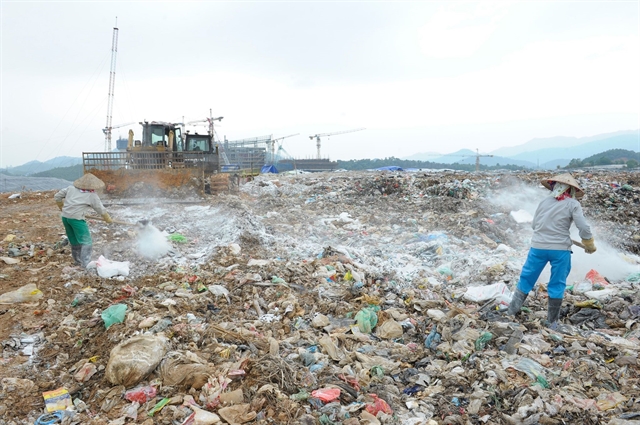 Society
Society

Almost all landfills in Hà Nội are at bursting point – overloaded with garbage and causing a serious headache for local authorities.

|
| Workers spread substances to curb odours from garbage at Nam Sơn landfill in Hà Nội's Sóc Sơn District. — VNA/VNS Photo Mạnh Khánh |
HÀ NỘI — Almost all landfills in Hà Nội are at bursting point – overloaded with garbage and causing a serious headache for local authorities.
While officials say they are concerned about the growing mountain of trash, there are a number of new waste treatment centres close to beginning operations.
And over the next 10 years, more high-tech landfill sites will be created.
The biggest site in Nam Sơn opened in 1999 and covers an area of 157 ha with further expansions planned over the next thirty years.
It receives around 5,000 tonnes of garbage each day, reaching 1.8 million tonnes every year serving 12 inner districts and five suburbs of the capital.
This vast amount of rubbish has caused the authorities to look for alternative measures to solve the garbage problems.
Thiên Ý Hà Nội Environment and Energy Joint Stocks Company were granted an investment licence to build a VNĐ 7 trillion waste-to-energy plant at the Nam Sơn.
It was expected to handle 4,000 tonnes of garbage daily, generating about 75 MW per hour.
But construction of the new facility was delayed because of the COVID-19 pandemic, according to the investor.
It now says it should be operational later this year.
Xuân Sơn landfill in Ba Vì District receives garbage from 12 suburban districts of Ba Vì, Chương Mỹ, Đan Phượng, Hoài Đức, Mỹ Đức, Phúc Thọ, Phú Xuyên, Quốc Oai, Thạch Thất, Thanh Oai, Thường Tín, Ứng Hòa and Sơn Tây Town.
About 1,500 tonnes of garbage is transferred to the landfill daily, of which, 1,400 tonnes is buried and the rest burnt.
Cầu Diễn landfill in Nam Từ Liêm District mostly deals with medical waste and toilet waste. Two other landfills in the city – Kiêu Kị Waste treatment area in Gia Lâm District and Phương Đình Waste Treatment Area in Đan Phượng District have both closed.
Solid waste is now gathered at Vân Nội and Nguyên Khê dumps in Đông Anh District and Vĩnh Quỳnh dump in Thanh Trì District. However, only the Nguyên Khê dump is now able to get rid of a modest volume of waste.
Nguyễn Hữu Tiến, Hà Nội Urban Environment One Member Limited Company (URENCO) Director General, said overloaded landfills pose high risks of air pollution, wastewater leakage and garbage mounting up because it cannot be buried quickly.
He also fears the situation will worsen as the weather gets warming.
Tiến said: “After Tết festival, the concentration of organic waste increased while it’s wet and warm during spring, this caused difficulties to control the smell discharged from the garbage.”
There were also issues with local residents who live near the plants angry over the increasing amount of rubbish. Demonstrations at the site prevented trucks from entering and caused a huge garbage backlog.
But there is light at the end of the tunnel.
According to Hà Nội’s Construction Department, investment procedures of three waste-to-power projects in the city are being completed.
The three projects are in Sơn Tây Town and Ba Vì District and can handle an extra 3,000 tonnes of garbage each day.
In Việt Hùng Commune, Đông Anh District, an industrial waste depot is almost complete, but investors are asking for permission to treat medical waste as well as industrial waste.
If Government approves their proposal, the plant would start operating in July, a representative of the Việt Hùng plant said.
Nguyễn Trúc Anh, Director of Hà Nội’s Planning and Architecture Department said that by 2030, Hà Nội plans to have 17 waste treatment areas.
The municipal authorities were stepping up land clearance to make room for waste treatment projects and called for investment including Châu Can in Phú Xuyên District, Phù Đổng in Gia Lâm District, Đồng Ké, Núi Thoong in Chương Mỹ District, Đông Lỗ in Ứng Hòa District, lại Thượng in Thạch Thất District and Hợp Thanh in Mỹ Đức District.
The waste treatment areas ranged from 4 ha to 20 ha with the capacity of 500-1,200 tonnes of garbage daily.
Anh said: “Under the plans, more waste treatment plants would be built in Hà Nội to help reduce the distance from the places where garbage is gathered to the places where the garbage is treated.
“The distance is about 10-30 km, so garbage would not be carried through inner-city areas.”
Nguyễn Trọng Đông, vice chairman of Hà Nội People’s Committee said the city asked relevant agencies to help solve difficulties for waste-to-energy plant projects.
Authorities in districts of Sóc Sơn, Ba Vì, Sơn Tây Town and other districts with waste treatment projects were asked to speed up land clearance to make room for the projects, Đông said.
He added: “With such a huge amount and increase in volume of garbage, Hà Nội identified two key solutions to the issue.”
While the city is looking for investors who can incorporate modern technology in their waste control methods, they are also asking the public to ensure they categorise garbage at source and work together to improve waste management for future generations. — VNS